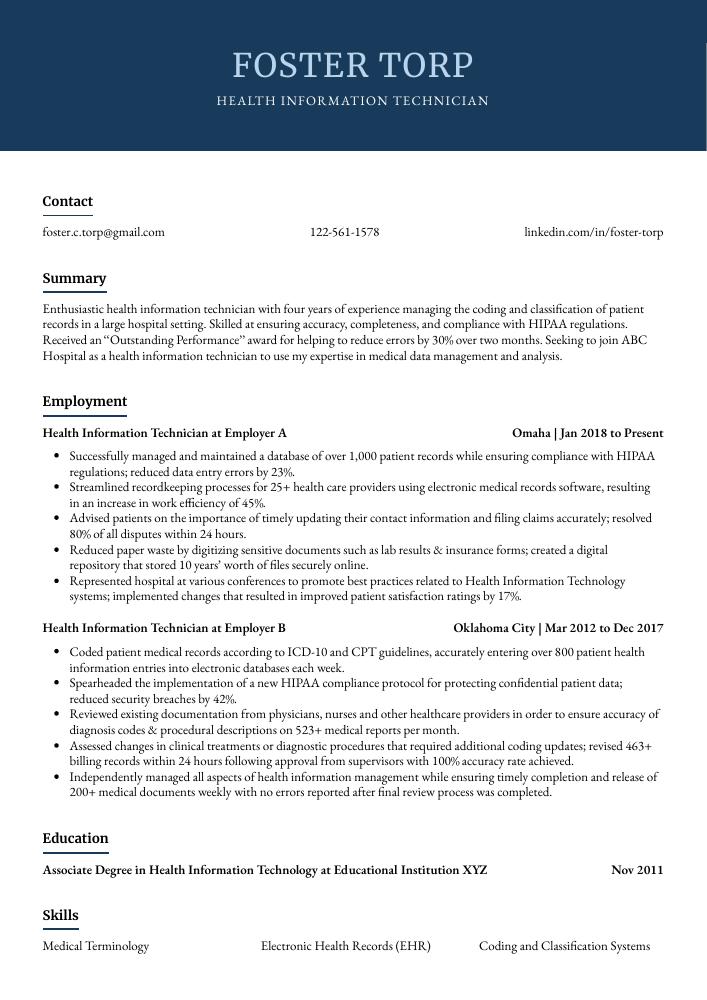Health Information Technician Resume Guide
Health Information Technicians manage and organize patient health information data. They use various classification systems to code and categorize medical records for insurance reimbursement purposes, as well as maintain patients’ personal information in electronic databases. Additionally, they may also prepare statistical reports on diseases and treatments for hospital administration or public health agencies.
You have a knack for organizing, managing, and analyzing medical records. Your expertise could be an invaluable asset to any healthcare organization—but they won’t know who you are unless you write a resume that speaks volumes about your qualifications.
This guide will walk you through the entire process of creating a top-notch resume. We first show you a complete example and then break down what each resume section should look like.
Table of Contents
The guide is divided into sections for your convenience. You can read it from beginning to end or use the table of contents below to jump to a specific part.
Health Information Technician Resume Sample
Foster Torp
Health Information Technician
[email protected]
122-561-1578
linkedin.com/in/foster-torp
Summary
Enthusiastic health information technician with four years of experience managing the coding and classification of patient records in a large hospital setting. Skilled at ensuring accuracy, completeness, and compliance with HIPAA regulations. Received an “Outstanding Performance” award for helping to reduce errors by 30% over two months. Seeking to join ABC Hospital as a health information technician to use my expertise in medical data management and analysis.
Experience
Health Information Technician, Employer A
Omaha, Jan 2018 – Present
- Successfully managed and maintained a database of over 1,000 patient records while ensuring compliance with HIPAA regulations; reduced data entry errors by 23%.
- Streamlined recordkeeping processes for 25+ health care providers using electronic medical records software, resulting in an increase in work efficiency of 45%.
- Advised patients on the importance of timely updating their contact information and filing claims accurately; resolved 80% of all disputes within 24 hours.
- Reduced paper waste by digitizing sensitive documents such as lab results & insurance forms; created a digital repository that stored 10 years’ worth of files securely online.
- Represented hospital at various conferences to promote best practices related to Health Information Technology systems; implemented changes that resulted in improved patient satisfaction ratings by 17%.
Health Information Technician, Employer B
Oklahoma City, Mar 2012 – Dec 2017
- Coded patient medical records according to ICD-10 and CPT guidelines, accurately entering over 800 patient health information entries into electronic databases each week.
- Spearheaded the implementation of a new HIPAA compliance protocol for protecting confidential patient data; reduced security breaches by 42%.
- Reviewed existing documentation from physicians, nurses and other healthcare providers in order to ensure accuracy of diagnosis codes & procedural descriptions on 523+ medical reports per month.
- Assessed changes in clinical treatments or diagnostic procedures that required additional coding updates; revised 463+ billing records within 24 hours following approval from supervisors with 100% accuracy rate achieved.
- Independently managed all aspects of health information management while ensuring timely completion and release of 200+ medical documents weekly with no errors reported after final review process was completed.
Skills
- Medical Terminology
- Electronic Health Records (EHR)
- Coding and Classification Systems
- HIPAA Compliance
- Data Entry
- Medical Billing and Coding
- Quality Assurance
- Patient Confidentiality
- Microsoft Office Suite
Education
Associate Degree in Health Information Technology
Educational Institution XYZ
Nov 2011
Certifications
Registered Health Information Technician (RHIT)
American Health Information Management Association
May 2017
1. Summary / Objective
Your resume summary should provide a snapshot of your skills and experience as a health information technician. In this section, you can highlight the coding systems you are familiar with, any certifications or qualifications that make you stand out from other applicants, and how many years of experience in the field you have. You could also mention how well-versed you are in HIPAA compliance regulations and patient confidentiality laws.
Below are some resume summary examples:
Diligent Health Information Technician with 10+ years of experience verifying, coding and maintaining medical records in compliance with HIPAA regulations. Gained expertise in various EMR systems, including Epic and Cerner. Proven track record for accurately analyzing patient data to generate meaningful reports that inform clinical decision-making. Seeking to utilize my skills at ABC Clinic to ensure efficient management of health information databases.
Accomplished health information technician with 5+ years of experience managing and organizing medical records. Skilled in the use of various software applications to analyze, update, and maintain electronic databases for accuracy and completeness. At XYZ hospital, maintained a 99% accuracy rate on all patient documentation. Received an award for exemplary performance from colleagues at ABC clinic after reducing errors by 33%.
Skilled health information technician with six years of experience in hospital settings, providing critical support to health care providers. At XYZ Hospital, managed and maintained patient records for over 200 patients per day and supported the implementation of a new EHR system that increased efficiency by 22%. Now looking to join ABC Health Care as an HIT Technician and use my expertise to help streamline operations.
Determined and patient-focused Health Information Technician with 5+ years of experience processing medical records and information. Efficiently managed data entry into electronic health record systems while ensuring accuracy and compliance with HIPAA regulations. At ABC, organized over 300 paper charts in preparation for transitioning to an electronic system. Developed processes to expedite the charting process by 15%.
Driven and detail-oriented health information technician with over 7 years of experience working in a fast-paced medical environment. Skilled at managing and maintaining patient records, analyzing data for accuracy, and interfacing with multiple stakeholders to ensure compliance. Seeking to leverage knowledge of HIPAA regulations and ICD coding to become the next Health Information Technician at ABC Medical Center.
Proficient health information technician with 5+ years of experience in collecting and managing patient data. Skilled at accurately coding diagnoses, procedures, and medications for all types of healthcare facilities. Certified by the American Health Information Management Association (AHIMA). Seeking to join ABC Medical Center as a health information specialist to help streamline their documentation processes.
Energetic health information technician with 3+ years of experience managing medical records in a hospital setting. Experienced in coding and abstracting patient data, as well as processing insurance claims. At XYZ Hospital, led the implementation of new software to streamline record-keeping processes by 20%. Committed to accuracy and best practices while providing timely services for all clients.
Passionate and experienced health information technician with 5+ years of experience in medical records and coding. Seeking to use expertise at XYZ Medical Center, where I can utilize my knowledge of HIPAA regulations and state laws to ensure accuracy and confidentiality for each patient’s record. Experienced in working with multiple EMR systems, including Cerner, Epic, NextGen and Meditech.
2. Experience / Employment
The work history/experience section is where you provide details on your past employment. This should be written in reverse chronological order, meaning the most recent job is listed first.
When writing this section, use bullet points to break up the text and make it easier for readers to take in what you have said quickly. When providing information about each role, focus on quantifiable results and specific tasks that were completed successfully.
For example, instead of saying “Managed patient records,” you could say “Maintained accurate electronic health records for over 1,000 patients per month; worked with physicians to ensure accuracy of data entry.”
To write effective bullet points, begin with a strong verb or adverb. Industry specific verbs to use are:
- Processed
- Coded
- Analyzed
- Compiled
- Assessed
- Monitored
- Updated
- Organized
- Managed
- Entered
- Reviewed
- Researched
- Reconciled
- Validated
Other general verbs you can use are:
- Achieved
- Advised
- Coordinated
- Demonstrated
- Developed
- Expedited
- Facilitated
- Formulated
- Improved
- Introduced
- Mentored
- Optimized
- Participated
- Prepared
- Presented
- Reduced
- Reorganized
- Represented
- Revised
- Spearheaded
- Streamlined
- Structured
- Utilized
Below are some example bullet points:
- Consistently maintained and updated medical records for over 350 patients, ensuring accuracy and adherence to HIPAA standards.
- Introduced a new filing system that reduced data entry time by 30%, resulting in increased productivity of the department.
- Reorganized health information databases on an ongoing basis; upgraded 7 existing systems with new coding practices and improved patient confidentiality protocols.
- Utilized specialized software programs such as ICD-10-CM & CPT codes to accurately classify medical diagnoses, treatments and procedures for billing purposes; achieved 99% accuracy rate during code assignments – leading to a 4% reduction in denied claims from insurance companies due to incorrect coding errors.
- Structured electronic health record (EHR) summaries using standardized templates; generated patient profiles containing vital statistics, laboratory results, hospitalizations history & medication lists within an average turnaround time of 3 hours or less each day.
- Demonstrated exceptional data entry accuracy when entering patient health information into electronic medical records, increasing efficiency by 30%.
- Mentored 3 junior technicians in coding and abstracting procedures for improved quality control; led to a decrease of 15% in errors within the first month.
- Monitored healthcare databases on a weekly basis to ensure compliance with HIPAA regulations and other applicable laws, making sure all records were up-to-date and secure from unauthorized access or manipulation.
- Reconciled discrepancies between paper & electronic medical records while performing periodic audits; identified areas of improvement that reduced processing time by 10 hours per week across the department.
- Diligently maintained confidential patient information according to hospital policy standards, preserving privacy at all times during daily interactions with patients & staff members alike.
- Facilitated the accurate maintenance of medical records for over 500 patients, ensuring that all information was up-to-date and compliant with HIPAA regulations.
- Analyzed patient data to confirm accuracy before entering into Electronic Health Record (EHR) system; reduced errors by 79%.
- Entered patient demographic, clinical and insurance information timely into EHR systems while maintaining the highest level of confidentiality in compliance with HIPAA laws.
- Prepared detailed reports on requested statistical health care data promptly and accurately using specialized software programs such as Microsoft Excel; increased efficiency rate by 22%.
- Efficiently processed requests from healthcare providers within 24 hours or less while adhering to established coding guidelines and protocols set forth by management personnel.
- Revised and updated over 3,000 patient medical records to ensure accuracy and compliance with prevailing HIPAA regulations; successfully reduced errors in health information by 15%.
- Expedited the release of confidential patient information for legal purposes upon request from law enforcement agencies or government officials; processed requests within 24 hours on average.
- Organized electronic medical records into an easy-to-navigate database system that was accessible to authorized personnel only; improved data access time by 40% while maintaining strict security protocols at all times.
- Formulated accurate statistical reports regarding disease outbreaks, mortality rates and other public health issues using ICD codes & CPT guidelines according to specific requirements of local governing bodies; increased reporting speed by 30%.
- Accurately transcribed physicians’ orders, laboratory results and diagnostic tests into digital databases within specified deadlines (average 4 hours) without compromising quality standards or regulatory compliance measures in any way.
- Reliably managed the medical records of over 500 patients daily, ensuring accuracy and compliance with HIPAA regulations.
- Improved patient data management efficiency by 25% through streamlining current processes and implementing new technology solutions.
- Participated in developing a comprehensive database of medical codes for use when entering diagnoses, treatments and procedures into electronic health records (EHR).
- Researched discrepancies between invoices from providers across different insurance companies to verify correct billing information; resolved 80% of cases within 48 hours or less on average.
- Assisted in providing clinical summaries to physicians upon request; identified errors in references or citations an average 10 minutes faster than peers due to knowledge base acquired during HIM certification program completion.
- Developed comprehensive electronic health records for over 500 patients, including medical histories, treatments and outcomes; improved data accuracy by 28%.
- Actively maintained up-to-date patient information in the system through periodic verifications with hospital staff to ensure accuracy of all documents.
- Compiled detailed reports on billing activities and distributed them to relevant departments within tight deadlines; reduced processing time by 25% per report.
- Presented analytical summaries of departmental performance at monthly meetings using modern presentation tools such as MS PowerPoint & Prezi; increased understanding amongst stakeholders by 15%.
- Achieved certification from AHIMA (American Health Information Management Association) after passing a comprehensive exam demonstrating proficiency in health information management processes and technologies.
- Updated patient medical records in electronic health information systems with accuracy and precision, reducing data entry errors by 30%.
- Optimized patient workflow processes to streamline administrative tasks, allowing for efficient retrieval of medical documents and saving up to 10 hours per week.
- Validated the integrity of patients’ health information such as test results, treatments received and diagnoses; identified gaps or discrepancies in patient data over 500 times throughout career thus far.
- Competently handled confidential sensitive material while protecting the privacy of hundreds of patients according to HIPAA guidelines during a three-year tenure at ABC Healthcare Center & Clinic.
- Coordinated with physicians on entering detailed clinical notes into each patient’s record accurately; enabled prompt updating of healthcare plans that resulted in improved care outcomes for more than 200 individuals annually.
3. Skills
Skill requirements will differ from employer to employer – this can easily be determined via the job advert. Organization ABC may require a candidate to be proficient in using certain software, while Organization XYZ may need someone who is experienced with coding medical records.
Therefore, you want to tailor the skills section of your resume to each job that you are applying for – this will ensure it stands out from other applicants and has a higher chance of being selected by an employer’s applicant tracking system (ATS).
In addition to just listing skills here, don’t forget about elaborating on them further in other sections such as the summary or experience section.
Below is a list of common skills & terms:
- Coding and Classification Systems
- Data Entry
- Electronic Health Records (EHR)
- HIPAA Compliance
- Medical Billing and Coding
- Medical Office Procedures
- Medical Terminology
- Microsoft Office Suite
- Patient Confidentiality
- Quality Assurance
4. Education
Mentioning your education on your resume will depend on how far along you are in your career. If you just graduated and have no prior experience, include an education section below the objective statement. On the other hand, if you have been working as a health information technician for several years with plenty of accomplishments to showcase, omitting the education section is perfectly fine.
If including an education section is necessary, try to mention courses related to healthcare technology or medical coding that are relevant to the job opening.
Associate Degree in Health Information Technology
Educational Institution XYZ
Nov 2011
5. Certifications
Certifications demonstrate to potential employers that you have the knowledge and skills necessary for a particular job. Having certifications can give you an edge over other applicants who may not possess them, making it important to include any relevant ones on your resume.
If there is a certification related to the position you are applying for, make sure to list it in this section of your resume so hiring managers will be aware of your qualifications.
Registered Health Information Technician (RHIT)
American Health Information Management Association
May 2017
6. Contact Info
Your name should be the first thing a reader sees when viewing your resume, so ensure its positioning is prominent. Your phone number should be written in the most commonly used format in your country/city/state, and your email address should be professional.
You can also choose to include a link to your LinkedIn profile, personal website, or other online platforms relevant to your industry.
Finally, name your resume file appropriately to help hiring managers; for Foster Torp, this would be Foster-Torp-resume.pdf or Foster-Torp-resume.docx.
7. Cover Letter
Including a cover letter with your job application is a great way to make yourself stand out from the competition. It allows you to express your personality and provide additional information about why you’re an ideal candidate for the role.
Cover letters usually consist of 2-4 paragraphs, with each paragraph providing details that are not already mentioned in your resume. Writing one also demonstrates professionalism and shows employers that you take initiative when applying for jobs.
Below is an example cover letter:
Dear Clyde,
I am writing in response to your ad for a Health Information Technician. With my training in medical coding and billing, as well as my experience working with electronic health records, I feel confident that I would be a valuable asset to your team.
In my current position at XYZ Hospital, I work closely with the medical staff to ensure that all patient information is accurately documented and coded. I have also been responsible for training new employees on our electronic health record system. My experience has taught me how important it is to maintain accurate and up-to-date patient records, and I am confident that I could bring this same level of dedication to your organization.
Health information technicians must be able to effectively communicate with both medical staff and patients. In my previous positions, I have excelled at building positive relationships with both groups. My interpersonal skills combined with my technical expertise make me confident that I would be an excellent fit for this position.
I would welcome the opportunity to discuss how my skills and experience could benefit your organization further during an interview at your earliest convenience. Thank you for your time and consideration; I look forward to hearing from you soon!
Sincerely,
Foster
Health Information Technician Resume Templates
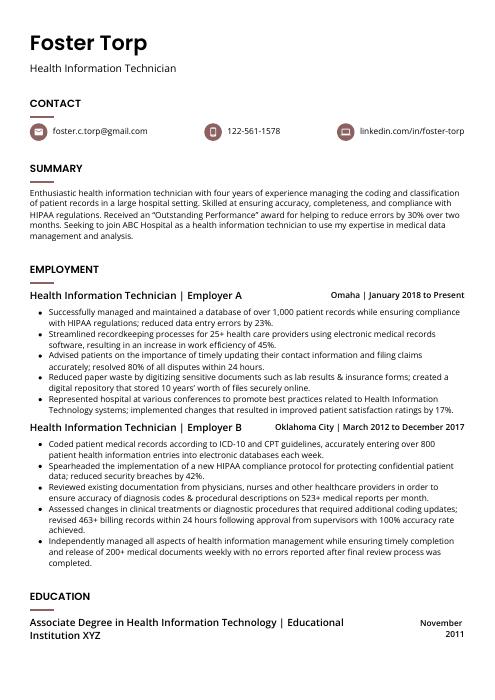 Fossa
Fossa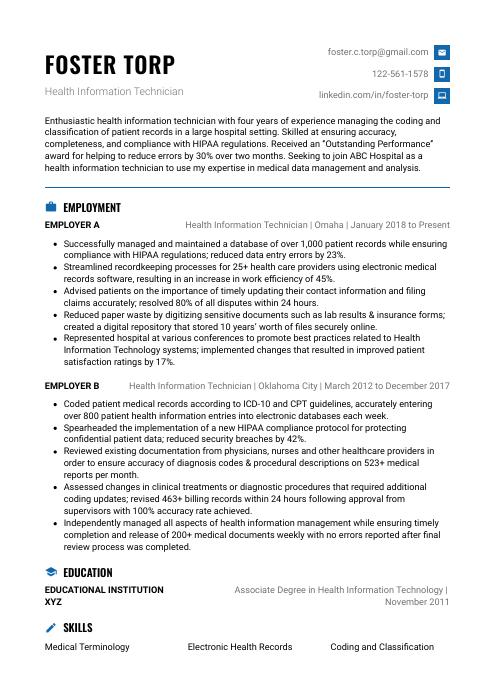 Echidna
Echidna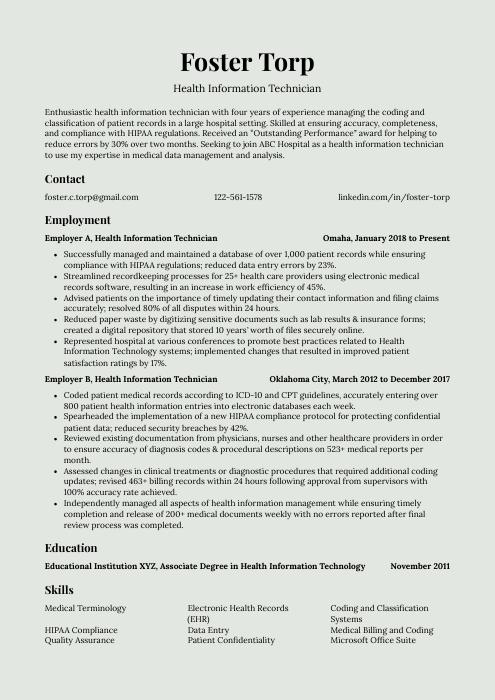 Saola
Saola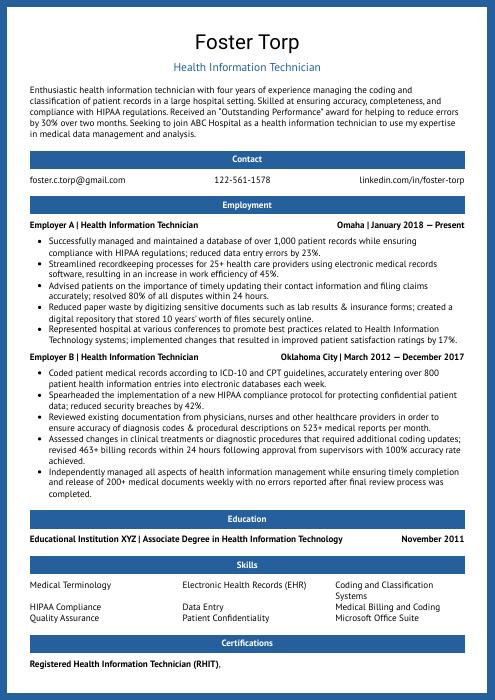 Ocelot
Ocelot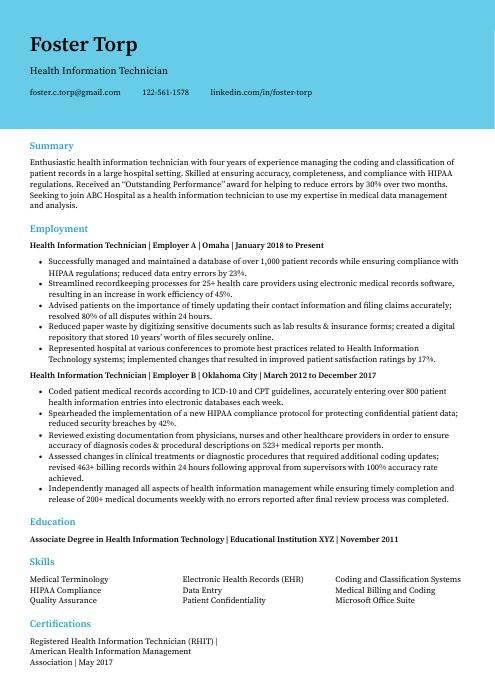 Dugong
Dugong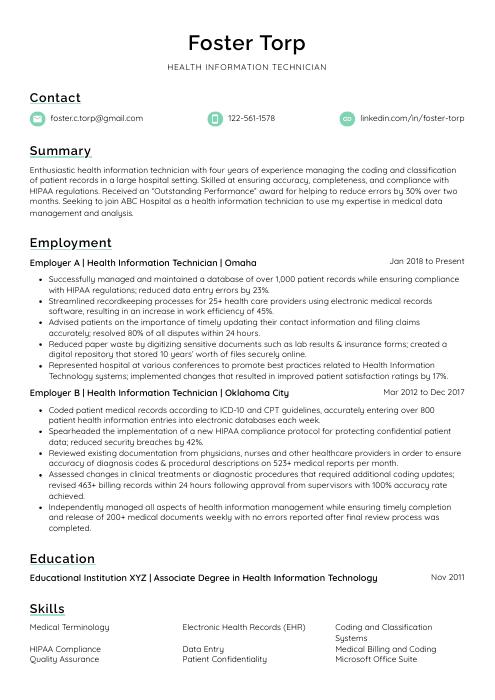 Lorikeet
Lorikeet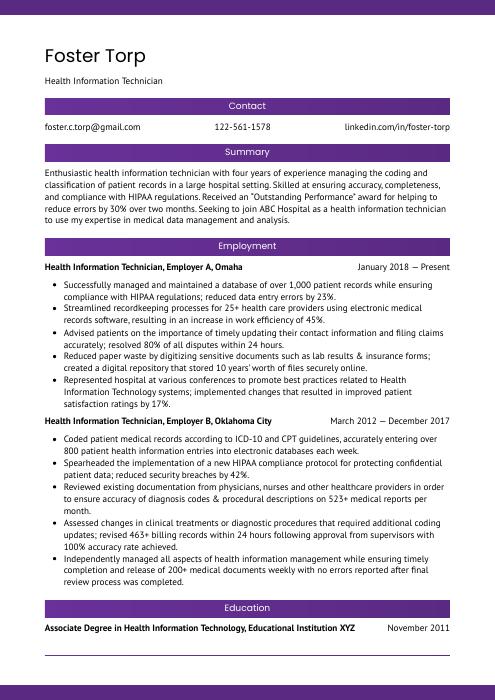 Jerboa
Jerboa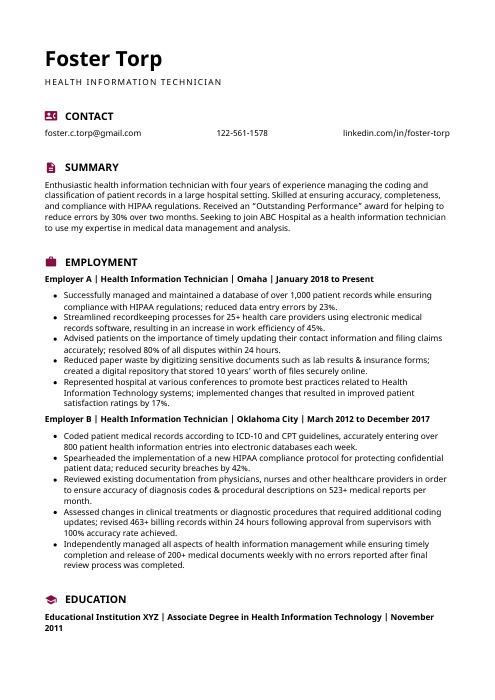 Hoopoe
Hoopoe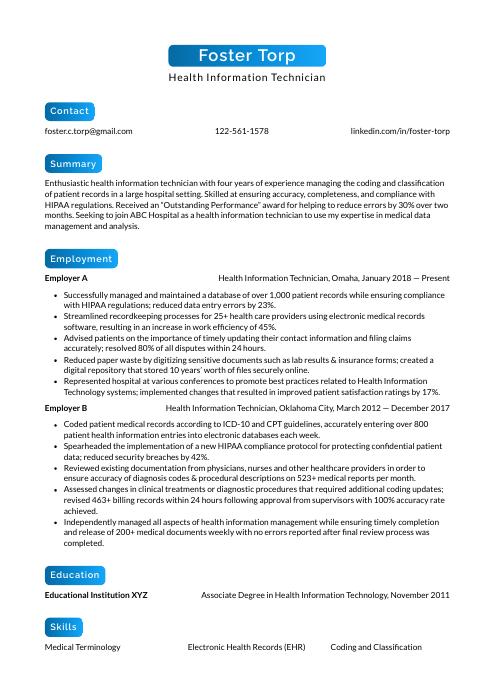 Kinkajou
Kinkajou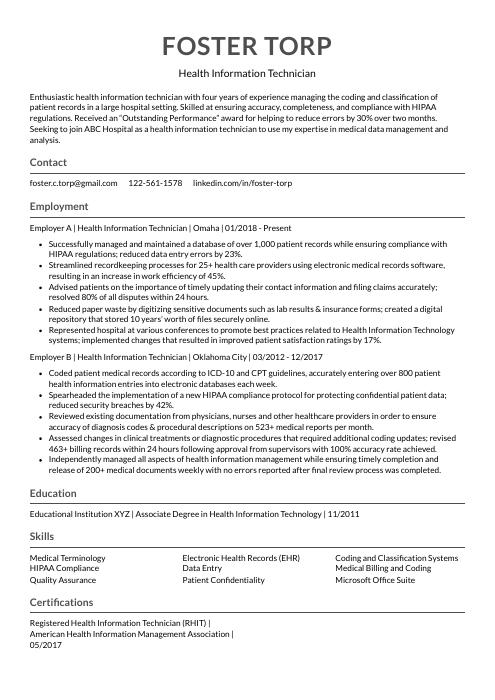 Indri
Indri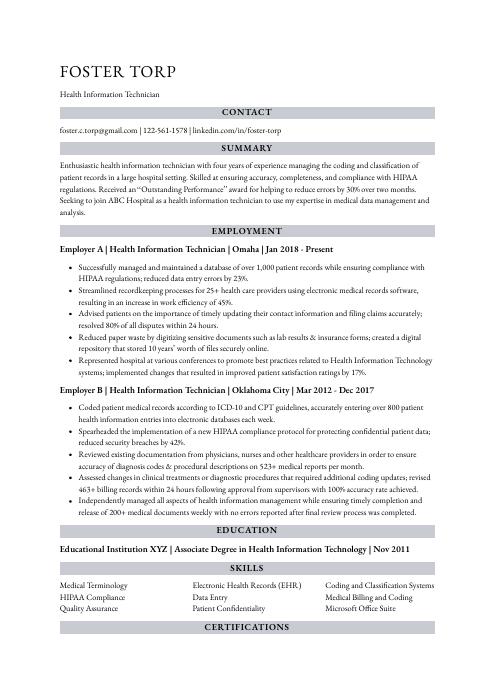 Numbat
Numbat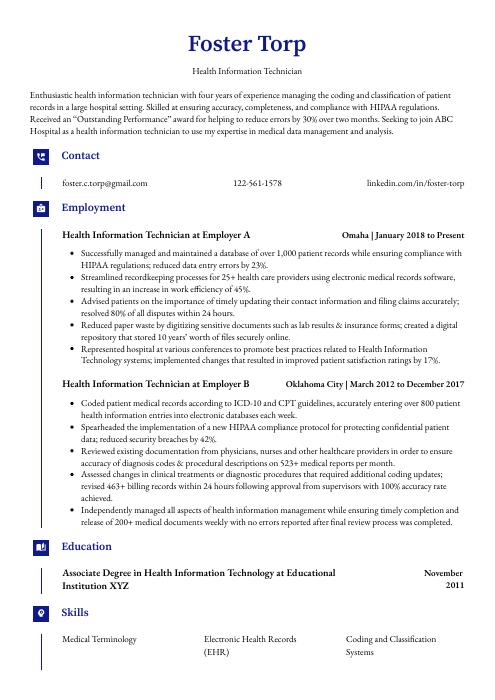 Gharial
Gharial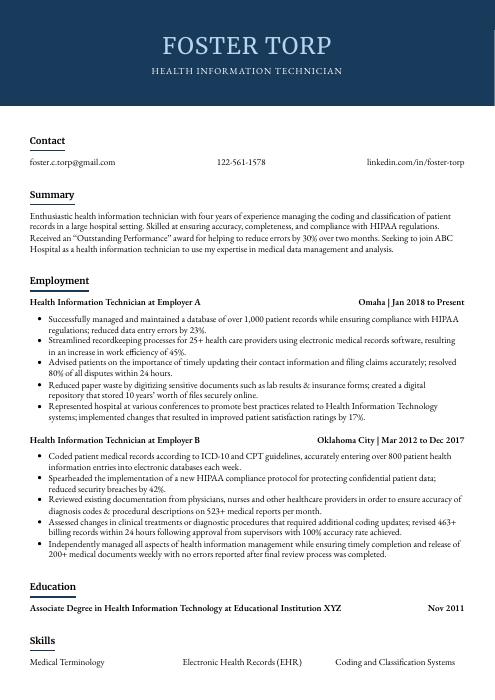 Bonobo
Bonobo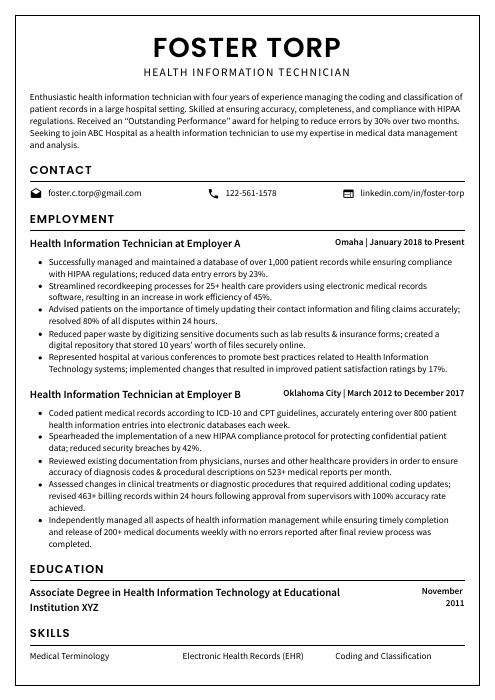 Cormorant
Cormorant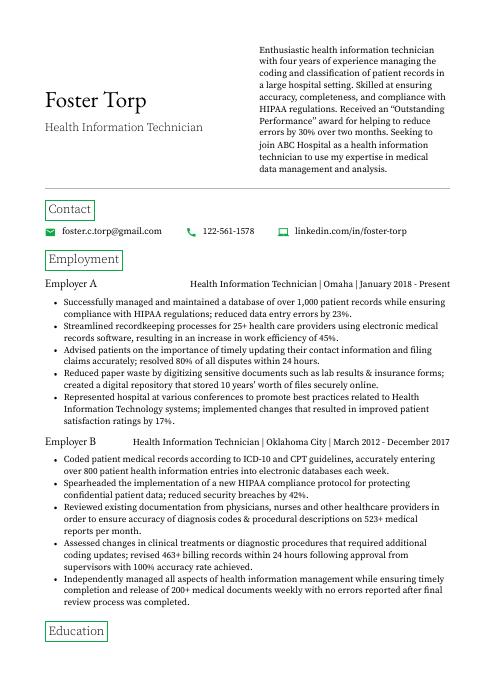 Quokka
Quokka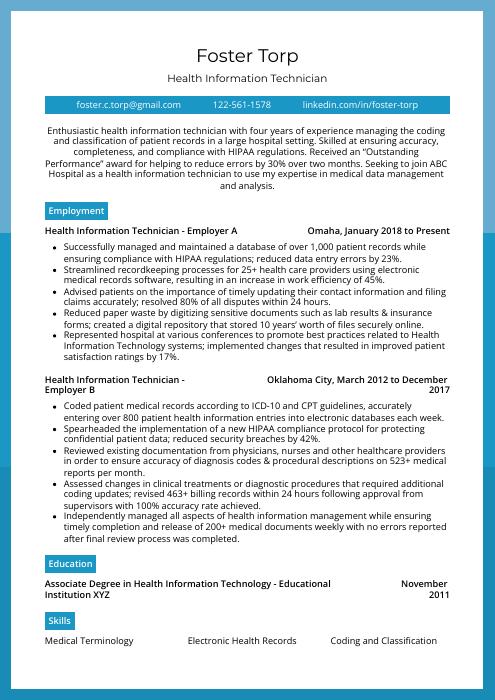 Rhea
Rhea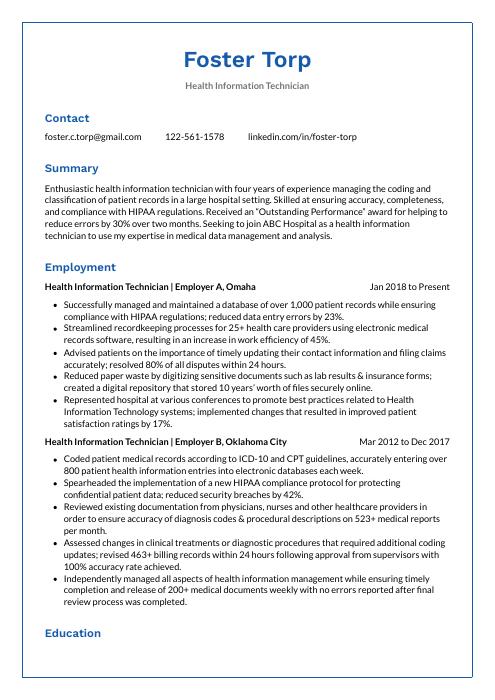 Markhor
Markhor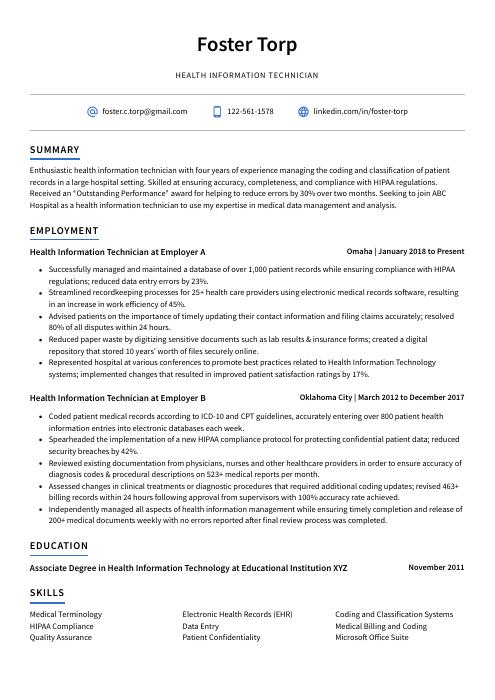 Axolotl
Axolotl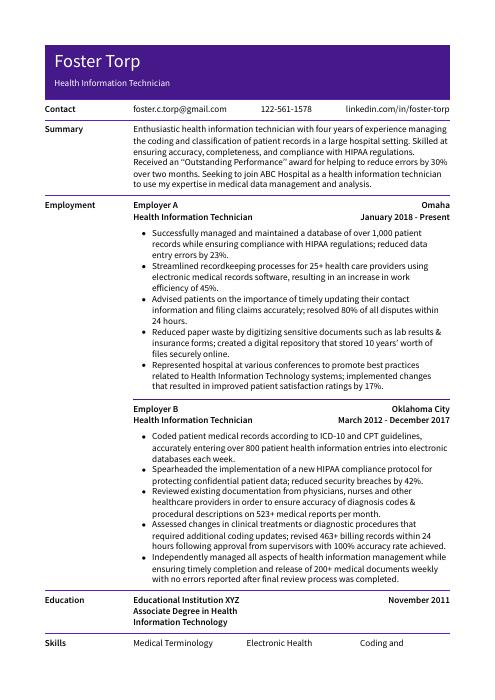 Pika
Pika Rezjumei
Rezjumei
